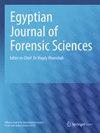An overview of DNA degradation and its implications in forensic caseworks
IF 1.3
Q3 MEDICINE, LEGAL
引用次数: 0
Abstract
DNA (deoxy-ribonucleic acid) is a fundamental molecule housing genetic information crucial for forensic casework. However, its integrity is compromised over time due to degradation, affecting living and deceased organisms. Understanding the factors and mechanisms of DNA degradation is vital across scientific disciplines. DNA degradation is a dynamic process influenced by factors like temperature, humidity, and ultraviolet radiation. The post-mortem interval affects organisms differently, and mechanisms such as hydrolysis, oxidation, and depurination impact DNA structural integrity. In forensic casework, DNA degradation poses challenges because degraded DNA samples can be difficult to analyze. Despite these challenges, DNA degradation has become an invaluable asset in forensic science. Fragmented DNA aids in historical identification and archaeological investigations. Additionally, DNA degradation helps estimate the time since death, assisting investigators in criminal timelines. Forensic experts use degradation patterns to deduce environmental conditions affecting a body, aiding crime scene reconstruction. In criminal investigations, advancements in DNA recovery, like next-generation sequencing, enable the analysis of severely degraded samples, enhancing the identification of suspects and victims. DNA degradation, despite its challenges, is a potent tool in forensic science. Understanding the factors and mechanisms influencing DNA degradation is essential for its effective utilization in criminal casework. With ongoing advancements in forensic techniques and technologies, the reliability and utility of degraded DNA analysis are steadily increasing, helping to bring resolution to complex criminal cases and uncovering hidden clues in forensic investigations.DNA 降解及其对法医办案的影响概述
DNA(脱氧核糖核酸)是一种基本分子,包含对法医办案至关重要的遗传信息。然而,随着时间的推移,DNA 的完整性会因降解而受到破坏,影响到活体和已死亡的生物体。了解 DNA 降解的因素和机制对各科学学科都至关重要。DNA 降解是一个受温度、湿度和紫外线辐射等因素影响的动态过程。死后间隔期对生物的影响各不相同,水解、氧化和去质化等机制都会影响 DNA 结构的完整性。在法医办案工作中,DNA 降解带来了挑战,因为降解的 DNA 样本可能难以分析。尽管存在这些挑战,DNA 降解已成为法医学的宝贵财富。支离破碎的 DNA 有助于历史鉴定和考古调查。此外,DNA 降解还有助于估算死亡时间,帮助调查人员确定犯罪时间表。法医专家利用降解模式来推断影响尸体的环境条件,从而帮助重建犯罪现场。在刑事调查中,DNA 恢复技术的进步(如下一代测序技术)使得对严重降解样本的分析成为可能,从而加强了对嫌疑人和受害者的识别。DNA 降解尽管具有挑战性,但却是法医学的有力工具。了解影响 DNA 降解的因素和机制对于在刑事案件工作中有效利用 DNA 至关重要。随着法医技术和科技的不断进步,降解 DNA 分析的可靠性和实用性也在稳步提高,有助于解决复杂的刑事案件,发现法医调查中隐藏的线索。
本文章由计算机程序翻译,如有差异,请以英文原文为准。
求助全文
约1分钟内获得全文
求助全文
来源期刊

Egyptian journal of forensic sciences
MEDICINE, LEGAL-
CiteScore
2.00
自引率
0.00%
发文量
51
审稿时长
17 weeks
期刊介绍:
Egyptian Journal of Forensic Sciences, the official publication of The International Association of Law and Forensic Sciences (IALFS), is an open access journal that publishes articles in the forensic sciences, pathology and clinical forensic medicine and its related specialities. The journal carries classic reviews, case studies, original research, hypotheses and learning points, offering critical analysis and scientific appraisal.
 求助内容:
求助内容: 应助结果提醒方式:
应助结果提醒方式:


